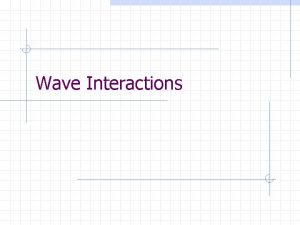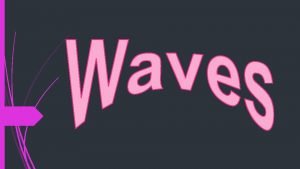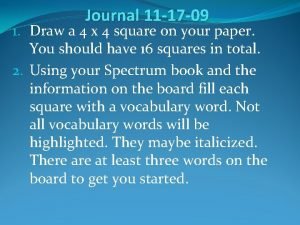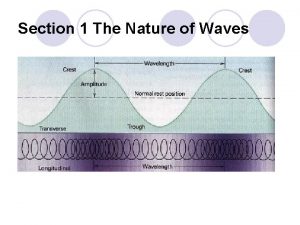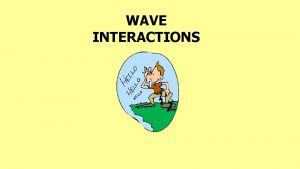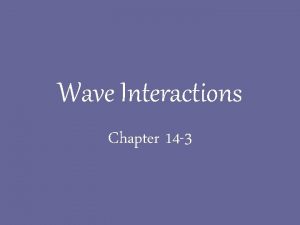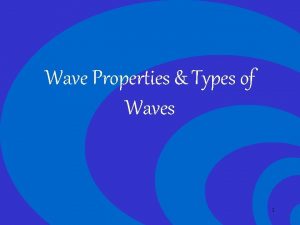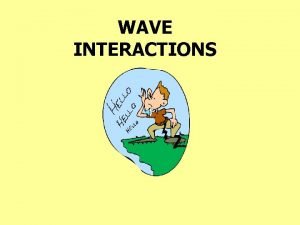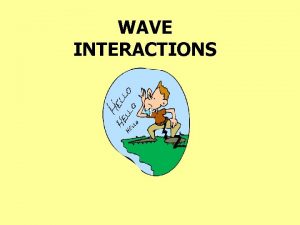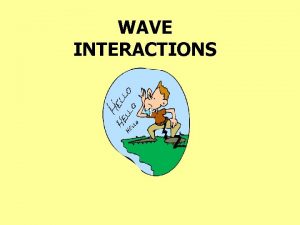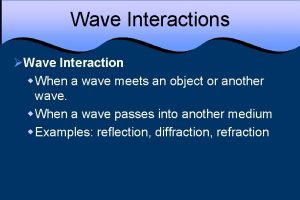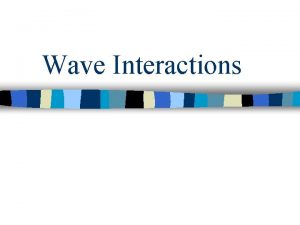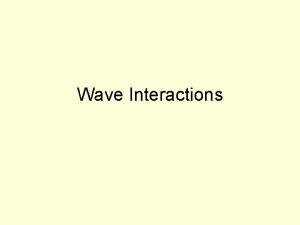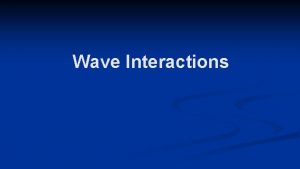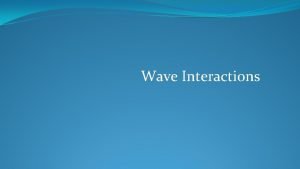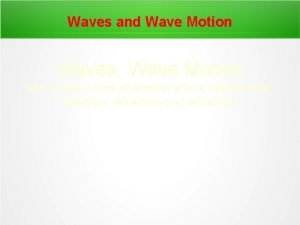Properties of Waves Interactions Wave Properties l There



















- Slides: 19

Properties of Waves & Interactions

Wave Properties l There are 4 properties of wave l Amplitude l Wavelength l Frequency l Wave speed

Wave Properties l Amplitude l The maximum distance that the particles of a wave vibrate from the rest position. l An other words from the rest position to the crest or from the rest position to the trough.

Wave Properties l Amplitude l Shows the amount of energy there is in a wave. l The bigger the amplitude the more energy there is.

Wave Properties l Wavelength l The distance from any point on a wave to an identical point on the next wave. l Generally measured from crest to crest on a transverse wave and from compression to compression on a longitudinal wave.

Wave Properties l Wavelength l The shorter the wavelength the more energy there is.

Wave Properties l Frequency l The number of waves produced in a given amount of time l Measured in Hertz (Hz) l 1 Hz=1/s (1 wave per second)

Wave Properties l Frequency l The higher the frequency the more energy

Wave Properties l Wave Speed l The speed at which a wave travels l V= λ x f v – wave speed λ – wavelength f – frequency l The wavelength and frequency of a wave in a certain medium depends on the wave speed not the other way around § http: //micro. magnet. fsu. edu/primer/java/wavebasics/index. html

Wave Interactions l There are 4 types of wave interactions l Reflection l Refraction l Diffraction l Interference

Wave Interactions Reflection l l The bouncing back of a wave when it hits a surface. * NOTE: When waves hits a substance some of it is transmitted and some of it is reflected. Transmitted means to pass through l This is why we can see objects and hear echoes.

Wave Interactions Refraction l The bending of waves as they pass through different mediums that cause the speed of the wave to change. l § Prism

Wave Interactions l Diffraction l Change of direction of a wave when it hits an obstacle or edge. § Sound diffracts well around corners § Light does not diffract as much because their wavelengths are shorter

Wave Interactions Interference l When 2 or more waves combine l l l Two objects can’t occupy the same space at the same time, but waves can. There are 4 types of interference l Constructive interference l Destructive interference l Standing waves l Resonance

Interference Constructive interference l l When the crest and trough of different waves match l They combine to make a wave with larger amplitude

Interference Destructive interference l l When the crest of one wave meets the trough of another l The results are a smaller amplitude or no amplitude

Interference Standing waves l l When waves combined they look like they are standing still, but are not. l It is a combination of constructive and destructive interference

Interference Resonance l l When 2 objects naturally vibrate at the same frequency. l The sound produced by one object causes the other to vibrate. l Body of a guitar resonates when the strings are strummed

Bibliography l l Holt, Rinehart, Winston, North Carolina Holt Science & Technology, Holt, Rinehart, Winston, Orlando, 2005 Google Images, http: //www. google. com/imghp, accessed 1/12/11
 Reflection wave interactions
Reflection wave interactions Type of mechanical waves
Type of mechanical waves Wave interactions
Wave interactions The properties and interactions of magnets
The properties and interactions of magnets Lowest point of a wave
Lowest point of a wave Sound waves are longitudinal waves true or false
Sound waves are longitudinal waves true or false Mechanical and electromagnetic waves similarities
Mechanical and electromagnetic waves similarities Similarities of mechanical waves and electromagnetic waves
Similarities of mechanical waves and electromagnetic waves Characteristics of a longitudinal wave
Characteristics of a longitudinal wave Whats a reflected sound wave
Whats a reflected sound wave Short wave vs long wave radiation
Short wave vs long wave radiation Difference between matter waves and electromagnetic waves
Difference between matter waves and electromagnetic waves Mechanical vs electromagnetic
Mechanical vs electromagnetic Mechanical waves and electromagnetic waves similarities
Mechanical waves and electromagnetic waves similarities Seismic waves
Seismic waves Is a seismic wave mechanical or electromagnetic
Is a seismic wave mechanical or electromagnetic Compare and contrast p waves and s waves using venn diagram
Compare and contrast p waves and s waves using venn diagram Mechanical and electromagnetic waves venn diagram
Mechanical and electromagnetic waves venn diagram Constructive waves and destructive waves difference
Constructive waves and destructive waves difference Ability of two or more waves to combine and form a new wave
Ability of two or more waves to combine and form a new wave
